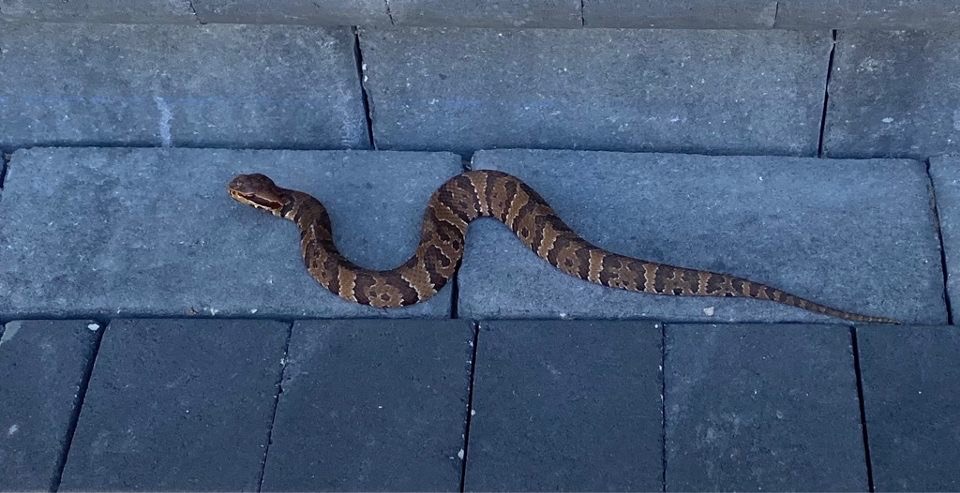For most people, finding a snake in your house or in your yard can be alarming. But the fact is, most snakes are harmless to humans, and many do the noble job of keeping more annoying pests (e.g., rodents) in check.
If you spot one in your yard, the best thing to do in most cases is to leave it alone, and it will probably go its own way eventually. Consistently seeing a snake on your property can be a sign of a rodent infestation.
Snakes are not the most noticeable creatures. They tend to hide and make little noise, so you might not see them in your house even if you have a full-fledged infestation. But even if you don’t see them directly, they do leave certain signs–namely, poop, skins, and tracks.
With that said, there are many steps you can take to make your house and yard unappealing to snakes.
Snake in the House
Snakes in the house typically enter either by accident or in search of food and shelter. Either way, most snakes tend to come in at the ground floor of a structure. The reptiles find entrances via gaps under doors or openings in the walls and foundations, around plumbing and vents, and even through pet doors.
Snakes prefer to hide in well-covered areas outside, including firewood piles, leaf litter, tall grasses, and rock walls. If such areas are near the structure, snakes can easily gain access to the home.
Homeowners may find snakes in various areas of the home, but most are found in basements, crawl spaces, dirt cellars, and garages. Certain tree dwelling snakes can enter into attics through holes in the roof, as well.
Where Do Snakes Hide in Your House?
Snakes in Walls
Snakes are nimble creatures able to squeeze into tight crevices and small spaces. They can find their way into buildings and walls through cracks and gaps in siding, windows, screens, brick, and wood foundations. The legless pests also gain access to homes and walls through drainage systems.
Snakes in Crawlspaces
Snakes typically enter homes at the ground level. Cracks in building foundations or walls larger than 1/4 of an inch in diameter are wide enough for most species of home-invading snakes to slither through and are the most common point of entrance for the pests. Vents, pipes, the spaces under doors, and gaps around utility and plumbing lines also make suitable entrances.
Dark, damp locations make perfect overwintering sites for snakes, who often hole up in crawl spaces when temperatures begin to drop. In the spring and summer, the pests tend to congregate in these areas looking for food like various species of rodents and insects. If snakes feel safe and have consistent access to food, they may decide to lay eggs. Residents may find multiple snakes in the crawl space, as a few species nest together.
Snakes in Basements
When the pests invade homes, they must enter through openings found in the building’s foundation. This may include cracks in the bedrock, slits under doorways, pet flaps, tunnels that lead under structures, and warped siding. Once inside, snakes search for secluded locations with plenty of food and often end up in basements or crawlspaces.
In the wild, the pests frequently rest in the spaces under rocks, and basements provide a similar environment. They offer consistent temperatures, moisture, darkness, relative quiet, and minimal activity, which makes them perfect for overwintering.
Property owners may also find snakes in the basement when rodent or insect infestations are present. Though different species of snakes prefer different food sources, rats, mice, and various types of insects are common prey. These pests are all commonly found in basements when they infest homes, thus making the basement attractive to hungry snakes.
Snakes in Attics
Attics are popular denning sites for snakes because they are often home to infestations of rodents and offer seclusion from human residents. Rats, mice, and squirrels are all prime sources of food for snakes, and when property owners find snakes in the attic, they almost certainly have a rodent infestation, as well. The upper floors of homes are also consistently warm and provide plenty of cover, so snakes can regulate their body temperature and stay hidden.
Since they don’t have arms or legs, snakes are not typically able to climb and therefore tend to infest homes at the ground level. However, certain species, including brown tree snakes, rat snakes, and various types of pythons, are agile climbers. They can easily scale trees and enter homes via chimneys, vents, open windows, and gaps in exterior siding. Once inside, they like to congregate in spaces that see very little human activity, such as wall cavities and attics.
Snakes in Bathrooms
Bathrooms, specifically the spaces around toilets and drains, are ideal hiding places thanks to their high moisture levels and relative darkness. Snakes gain access to these areas via the gaps around pipes where they enter buildings, or by swimming through plumbing into toilets.
Since some home-invading species are venomous, having snakes in toilets and bathrooms is dangerous, especially when house residents are unaware of their presence. Even non-venomous snakes pose threats, as they will lash out and bite if they feel cornered or threatened.
Snakes in Garages
Snakes are natural predators that hunt insects and small rodents. When unsecured containers of pet food or bird seed in the garage attract mice and cockroaches, it can create an ideal hunting ground for snakes. On hot, sunny days, snakes may also be attracted to the cool shade of an open garage, where they can take up residence beneath piles of junk, debris, or lumber.
Snakes in garages usually get there by slithering through an open door or a crack in the wall. However, they are also very good climbers and can enter through unsecured windows, loose roof tiles, or vents. Small openings around pipes, loose boards, and improperly sealed garage doors are all potential entry points.
How to Get Rid of Snakes Out of Your House
Snakes enter your home either to find shelter from the elements or to hunt for food (namely rodents). Although they are generally harmless, seeing a snake in the home is far from a pleasant surprise.
As snakes can be venomous and carry diseases, handling them directly is discouraged. Simply depriving them of food and shelter can yield good results:
- Eliminate food sources. No program for control of rodent-eating snakes is complete without removing rodents and habitats of rodents. Put all possible food sources for rodents in sealed containers. Be sure to clean up food for pets after each feeding and store it so that rodents won’t be able to get to it.
- Seal gaps. While snakes can squeeze through some very small openings, they can’t create new ones. All gaps exceeding 1/8th of an inch should be sealed with caulk. Holes in wooden structures can be sealed with sheet metal or 1/8th inch mesh hardware cloth.
- Reduce Clutter. Snakes love clutter, so if nothing else, a potential snake problem can be ample motivation to tidy up a bit. Try keeping your garage floor clear of anything that a snake could hide in or under. Storing wood piles off the ground (e.g., on a pallet) and keeping yards closely mowed and free of debris are other easy ways to make your home less hospitable to snakes.
- Set snake traps. If you suspect there are snakes in your garage, consider using funnel traps or glue boards. For the greatest effectiveness, set traps along walls and in corners. One downside of traps is that since they often use the smell of food to attract the snake, there exists the possibility of luring a snake inside your home with a trap. Live catching is also an option, but this can be risky and is best left to professionals.
- Call a professional. It is always best to contact a professional for snake removal, as snakes can be venomous and carry diseases. Furthermore, they usually occur alongside rodents, which are themselves a formidable nuisance that can be difficult to root out. For this reason, the safest option is always to consult with a professional.
Snakes are ectothermic, using the environmental temperature to regulate their body temperature. So as the temperatures drop, snakes need to find a warm place in order to remain active, which could be your home.
How to Get Snakes Out of Your Yard
Snakes in your yard may not be as bad as snakes in your house, but the sight of one can still be a bit jarring. If you do see a snake in your yard, the best thing to do is just leave it be, and it will probably leave eventually.
Snakes enjoy locations that offer both ample cover from predators and plenty of food. Potential food sources range from rodents and other small mammals, to reptiles and amphibians as well as insects. Many yards contain at least some form of snake food and often provide enough cover for use as shelter.
Yards harboring an abundance of food sources and sheltered locations attract high numbers of snakes and increase the potential for human encounters with the reptiles. Snakes in the grass or yard act as a form of natural pest control, but can also create undesirable outcomes.
Here are some things you can do to make sure your yard remains unappealing to snakes:
- Cut grass often. Snakes are less likely to rest and move in short grass, as it leaves them exposed to predators like owls and hawks.
- Avoid over-watering your lawn. Excessive water in your yard may attract worms, slugs, and frogs, which will, in turn, attract snakes.
- Feed pets inside. Pet food left outside is a surefire way to attract rodents, and rodents are a surefire way to attract snakes. Keep pet food sealed in tight containers, or better yet, keep it inside.
- Garden them out. Marigolds, lemongrass, Mother-in-Law’s tongue, wormwood, onion, and garlic are common plants that keep snakes away.
- Keep bird feeders away from the house, or get rid of them. The thrill of birdwatching comes at a price—and not just the price of bird seed. Birds are messy eaters and often leave scattered birdseed on the ground below the feeder. This attracts rodents, and, you guessed it, snakes.
- Consider using fencing. If the aforementioned measures don’t work, consider using ¼ of an inch or smaller rigid mesh or solid sheeting and bury it a few inches into the ground. Include a bend at the top to prevent snakes from climbing up and over.
- Don’t bring out guns, shovels, or other weapons. It’s true; snakes carry a stigma. Many people feel the urge to kill a snake the moment they lay eyes on it—even a harmless garden snake. This is not recommended, since not only are most snakes harmless to humans, even those that are venomous won’t go out of their way to attack. Plus, killing a snake requires one to get at least somewhat close to it, which can be dangerous in itself.
Professional Snake Control
Finding a snake in your yard once usually is not a big concern. If you leave it alone, it will leave you alone. If you see a snake consistently in your yard, there could be another pest problem.
Trutech technicians are experts at identifying factors and conditions that will increase snake activity. We can effectively trap snakes utilizing various traps and baits, as well as using snake deterrents to discourage snakes from wanting to stay in an area. Most importantly, the experts can identify any signs of a rodent infestation and deliver a rodent control program to solve all your nuisance animal problems.




